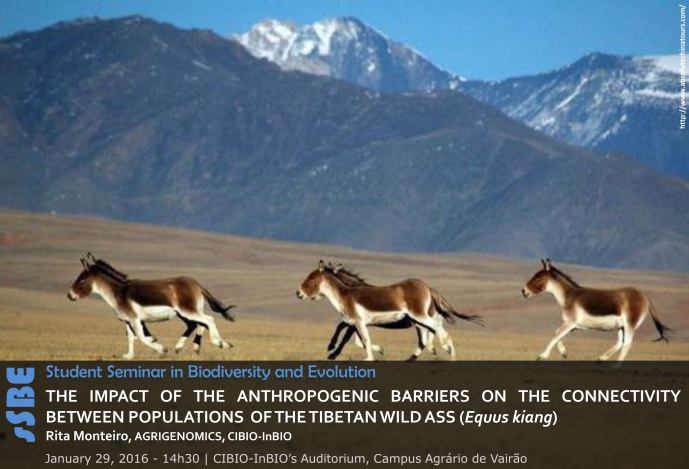THE IMPACT OF THE ANTHROPOGENIC BARRIERS ON THE CONNECTIVITY BETWEEN POPULATIONS OF THE TIBETAN WILD ASS (Equus kiang)

STUDENT SEMINAR IN BIODIVERSITY AND EVOLUTION

The two Asiatic wild ass species (Equus kiang and Equus hemionus) descend from the Eurasian spread of equids, around 4 My. From these, the E. kiang is among the least studied species and it urges to assess its genetic diversity and population structure as it is crucial to design adequate conservation and management programs. In this work, we have access the genetic diversity of several populations of this species using a noninvasive genetics approach. To evaluate the possible connectivity with its neighbor species, were also included several samples from E. hemionus from Kalamaili desert. This work was conducted based solely on a noninvasive sampling approach, and resorting to two regions from mitochondrial DNA (Control Region and Cytochrome b) and 7 microsatellite loci.
The obtained results revealed a rather stable without significant evidences of suffering from recent population constrains. However, it was noticed that artificial barriers have higher impact on populations connectivity than the geographic distance. The effect of three motorways on the long-distance dispersion of individuals among populations, was detected using the Monmonier's algorithm. Finally, phylogenetic analysis revealed that connectivity between Kiang and Hemionus population may have a very shallow history and molecular dating of the clades, have shown that both species may have diverged ~650 kya, which is in agreement with the past climatic events undergone during Pleistocene on Qinghai–Tibetan Plateau.
Graduated in Biology, and a Msc degree in Biodiversity, Genetics and Evolution, with a dissertation entitled “Population Genetics of the Tibetan wild ass (Equus kiang) and Evolution of the Equids”, Rita Monteiro’s main research interests are Population genetics and Conservation. Her work, developed in the context of the AGRIGENOMICS Group, has been mainly focused in assess he genetic diversity and population structure of several Asian wild ass (Equus kiang and Equus hemionus), distributed across the Asian continent, to evaluate the genetic status of these species, considering the increasing habitat fragmentation, using a non-invasive sampling approach . At the same time she is also studying the evolution of coat color from wild and domestic Equids in order to highlight the complexity among coat color genes function, and the role of both artificial and natural selection in the evolutionary history of these genes.
Image credits: http://www.absolutechinatours.com/china-travel/Tibet/travel-guide.htm